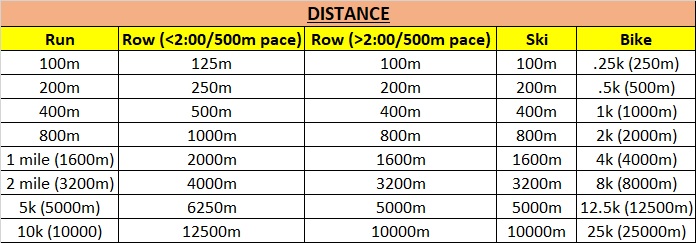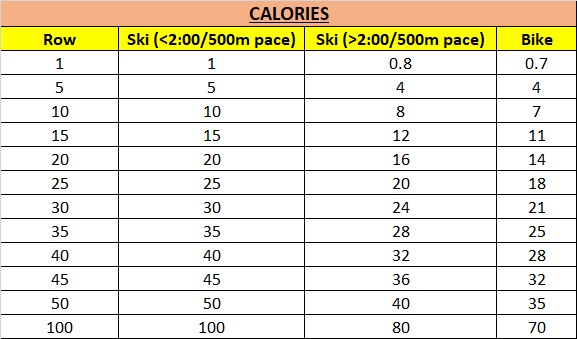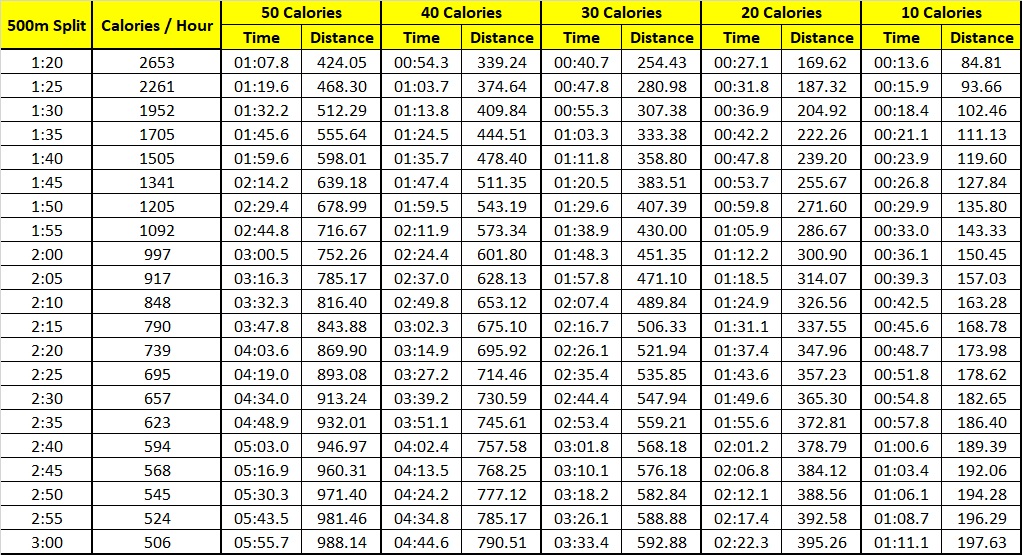Calories to Meters?
by Erik Castiglione
If you don’t feel like reading 735 words about how we convert, and why the calculations are what they are, just look at the tables provided and you’ll find your answers. For my fellow nerds, enjoy!
Meters to Meters
Rowing, running, biking, and skiing are what CrossFit refers to as “monostructural movements.” Based on equipment availability and working around injuries, we frequently interchange these movements. These substitutions are usually based on TIME as the constant factor. If an 8-minute mile pace is average, that means that my 400m run (1/4 mile) would take 2 minutes. So, how far can I row in 2 minutes? What about biking, or skiing?
For men, a 2-minute 500m row is “average.” For women, a 2:30 500m row is “average”, which means that in 2 minutes, a woman would row 400m. Of course, this is all subject to a great deal of individual variability based on the athlete. Therefore, our guideline at CFR is to substitute a 500m row for a 400m run if you can keep a 2:00/500m pace, or 400m if you cannot, rather than base it on gender.
Most people do not ski frequently and are therefore not very efficient. So, we keep our ski distance substitutions at a 1:1 ratio with running. Biking, on the other hand, can be picked up very quickly, and covers distance much more quickly than a rower. So, the standard substitution is a 2:1 bike to row distance. Taking all of this into account gives us this handy distance table:
Calories to Calories
When it comes to calorie conversions, you would think that a calorie is the same from rower, to bike, to skierg. It is a unit of energy, after all. For rowing and skiing, we use Concept 2 ergometers. The calories for these machines are determined using pre-programmed measurements, which assumes that the rower is a 175 lb male. Theoretically, from row erg to skierg, the calories should be the same. However, as previously mentioned, many of us do not ski as much as we row and are therefore less efficient at skiing. So, we expend MORE energy for fewer registered calories. Here, we can use the same criteria as rowing for distance: the ability to achieve a 2:00/500m pace. If you can ski with this kind of power, keep the calories the same for rowing and skiing. If not, ski calories should be 80% of the row calories.
The Assault Bike is not programmed with the same assumptions as the either of the ergometers, and therefore calculates calories differently. Based on measurements performed in labs, which saw athletes hooked up to all sorts of monitoring devices and measured power output over time, athletes expended 43% more energy on the Assault Bike than on the rower for the same amount of calories (as measured by those individual devices). Therefore, it is standard practice to use 70% of row calories for bike calories (rounding up where needed, of course), as the inverse of 143% is 70%. TL;DR version – use this table:
Calories to Meters
Now we get to the fun part: as a coach, I’m frequently asked “how many meters is 50 calories on the rower?” In other words, how do we get from energy to distance? If you’ll recall your high school physics, the SI unit for distance is meters. The SI unit for energy is joules, and 1 joule is 1 kg*m2/s2. To get distance out of this, we need to factor out force (1 newton [N] = 1 kg*m/s2 , and energy = work = force x distance). How can we possibly do this? Well, we don’t have to, because the ergometers do it for us by monitoring our power per stroke. Power = work/time and is measured in Watts. Calories are a unit of energy, and hours are a unit of time, so calories/hour is also a measure of power. The ergs also display your power as a per 500m pace. In other words, if you applied the same force consistently over 500m, this is the time it would take you. Thus, time is a factor, but we must also account for effort.
For example, our WOD on 051420 began and ended with a 50-calorie row. I started out with comfortable power and rowed it in 2:40. I covered around 710m in this time. For the final row, I was gassed. It took me just under 3:00 to row 50 calories, and this time I covered 765m. Even though I rowed a greater distance, my energy expenditure was the same, and my time was longer. I was less powerful. So, how do we make sense of all this? How do we get from calories to meters? We follow a 4-step process:
Step 1: Figure out your typical 500m pace (most people know this better than their cal/hr)
Step 2: Use the corresponding calories/hour
Step 3: Figure out how long it would take you to row the WOD’s calories at that pace
Step 4: Determine how far you would travel maintaining the pace in step 4 for the time from step 3. That’s your equivalent row distance.
Or, you could just look at this table, and then convert your row meters to the other devices as needed.:
Translate that into run/ski/bike distances as needed.



